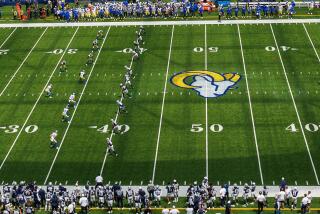NHL Is Still Adjusting to Faster, Cleaner Game
- Share via
As the NHL advances past the first quarter of its regular season, the decision to emphasize the enforcement of obstruction is getting mixed reviews.
In the NHL offices in Toronto, Andy VanHellemond, the director of officiating, said he believes the officials are getting better at making the calls and the players are getting better at playing this new, more skillful game.
“We didn’t do this to increase scoring,” VanHellemond said recently. “We did it to improve the game, create more chances and make it a more energized game. You can look at the stats and see it’s working. There have been 45 fewer fights (after one-fourth of the league schedule) and 90 less majors for fighting. That means there isn’t as much contact during the course of the game. It means there is more movement and less grabbing on.”
The game is being cleaned up. And because of that, even though increasing scoring was not the NHL’s goal, goal scoring was up 6% over last season.
Still, there are many more players and coaches who are happier with the new faceoff rule that has speeded up the game by 16 minutes than there are those happy with the obstruction crackdown, even though that crackdown is designed to create freer movement through the neutral zone so the quick, highly skilled players can perform better offensively.
“The speed-up of the game is great,” said Washington Capitals Coach Bruce Cassidy. “I’m home, got my three beers and in bed by 11:30 p.m.”
Cassidy has been less thrilled with the manner in which the obstruction situation has been handled.
“From one night to the next, you hope you’re not the team they [the officials] decide to single out,” he said. “I guess they’ve eliminated some obstruction, but I think from night to night [it’s uneven].
“But I’m fine with it. Let’s see a full season and playoffs. Ultimately, it’s the fans’ sport and if this creates more entertaining hockey, then that’s good.”
There seems little doubt that the hockey is better. The speed of the game has increased on the ice and on the game clock, and one rule seems to be affecting the other.
Because obstruction is being called, there is less hooking, holding and tripping in the neutral zone. That means more space to work and less frustration. The quick drop of the puck on faceoffs also eliminates the time players used to spend jawing with and agitating one another. Combined, it has resulted in fewer roughing and fighting penalties.
And all of that goes to explain why power-play goals were up by 114 in the first 310 games, while the number of power plays increased only one per game.
“There has been an increase of power plays in the neutral zone, but roughing is down 108 minor penalties,” VanHellemond said. “There isn’t as much contact during the course of the game, and it is making a difference.”
VanHellemond said there is a debate among fans, players and coaches over what exactly constitutes obstruction, but said there is no debate in his office.
“There are no degrees of infraction,” VanHellemond said. “It’s like if the goalie shoots the puck over the glass. He may not have intended to, but it’s a penalty. With obstruction, it is the same. It may just be a little hook that throws another player off stride, but it’s still a penalty. You used to be able to slingshot past with a hook, but that’s a penalty now. The way the game is played now is creating more excitement and energy.”
Ottawa Senators forward Mike Fisher, who freely acknowledges he is not one of the team’s “most skilled guys,” said he has enjoyed playing more this season because his game is primarily forechecking and that’s what officials want to see.
One of the most skilled on the Ottawa roster is Marian Hossa. The veteran right wing, who ranks among the league’s top 15 scorers, agrees the game is better, but sees recent inconsistency.
“In the beginning, it helped more because there were more calls and that meant more power plays,” Hossa said. “There was a little more room at the beginning. Now, they are calling it a little less. But I love it. The game should be more open, and there is certainly no problem for me to adjust.”
It has taken some teams longer than others to adjust. The Capitals, for instance, sometimes had to kill as many as eight or nine penalties per game at the beginning of the season.
“We’re getting the feel of it now,” Cap center Glen Metropolit said. “And it helps the little guys. It really does open the game a lot, creating room for someone like me [5 feet 10, 193 pounds] to get through to the offensive zone.”
Yet the Calgary Flames’ Jarome Iginla, who led the NHL in goals (52) and overall scoring (96 points) last season, had only six goals and 18 points in 27 games. He said he has not been helped by the new directive.
“I don’t know if there is any big difference,” he said. “I don’t know that it creates more space. I wouldn’t say the neutral zone is that much more open. I just don’t see it that way.”
And Jaromir Jagr has had some trouble adjusting to the cleaner play too. Though Cassidy said Jagr has not been protected as much by officials as he should be, Jagr leads the league in shots with 128 and the Caps in goals with 15. But getting on the scoreboard, said the right wing, has been more difficult than ever.
“I think I am missing the net because I am so used to guys hanging on me, the fact that they aren’t always there is throwing my shot off,” he said.
But it is the fact players such as Jagr, Hossa, Pittsburgh’s Mario Lemieux and Dallas’ Mike Modano are getting more goal-scoring chances that is making VanHellemond happy.
“It’s good to hear players like Jagr say those kinds of things,” VanHellemond said. “They are positive excuses. If you are a fast, quick, skilled player, you love this.”
More to Read
Go beyond the scoreboard
Get the latest on L.A.'s teams in the daily Sports Report newsletter.
You may occasionally receive promotional content from the Los Angeles Times.






